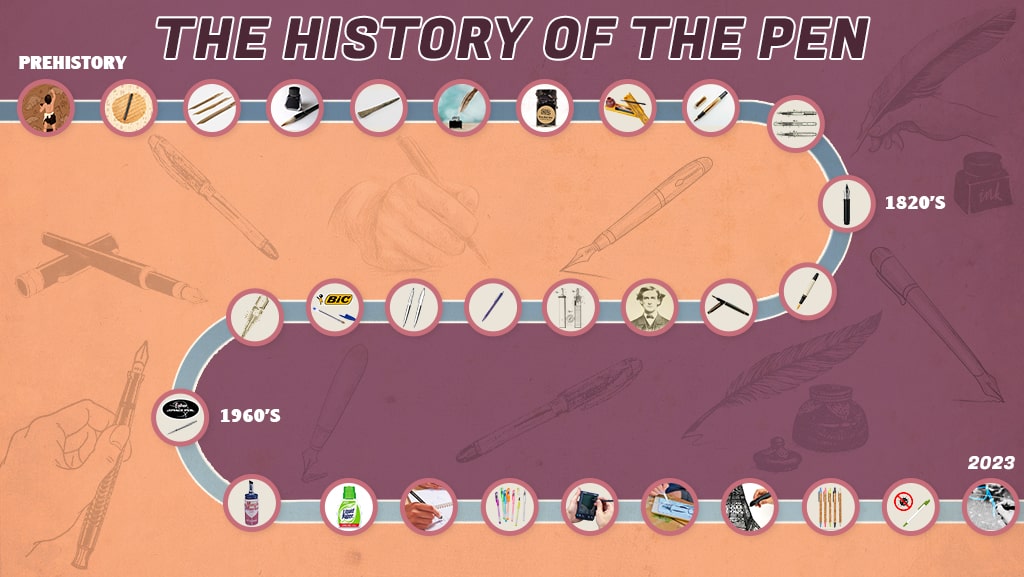
The History of the Pen: a Comprehensive Timeline
The Evolution of the Pen: from Feather Quills to 3D Printing
The written word is one of the most important human creations, allowing us to record and receive ideas in a permanent manner. From religious texts to political manifestos, the importance of writing is felt everywhere.
As humanity's favorite writing utensil, the pen has been essential to this development. But when was the pen created, and how has it progressed and changed over time? Join us as we travel from prehistoric cave paintings to augmented reality blueprints to discover how the pen has evolved.

The Cave Paintings of Prehistory
Recorded human history begins around 3000 BC, but the history of the pen goes back even further! Prehistoric cave paintings are the earliest known form of expression and storytelling, dating back around 40,000 years. Our creative ancestors depicted local animals and significant life events in their masterpieces, leaving behind a treasure trove of history on the walls of caves worldwide. In some regions, hollowed bones or twig brushes were used to paint the cave walls. These primitive utensils can be seen as the earliest precursors to pens!
It's fascinating to think that the origins of the pen can be found in prehistoric caves. These crude instruments paved the way for the innovative writing tools we enjoy today. Next time you pick up a pen, take a moment to appreciate the long and colorful journey it has taken to get to your fingertips.
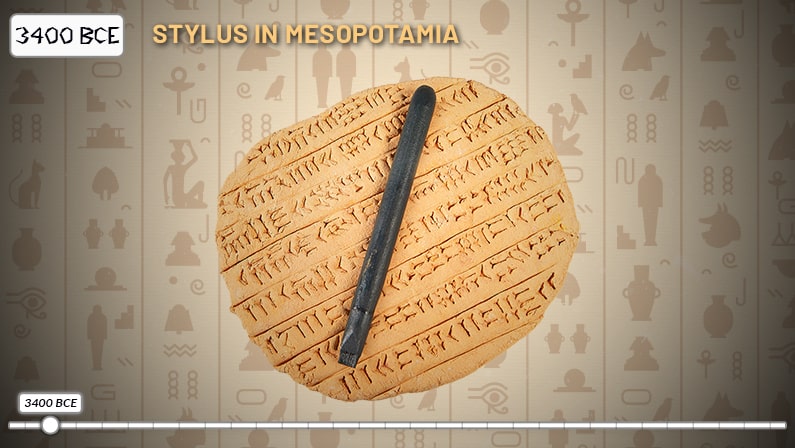
The Mesopotamian Stylus
The next development in the pen's storied history occurred in the cradle of civilization: Mesopotamia, circa 3400 BCE. It was here that the stylus was born. As the need for communication grew more complex, our ingenious ancestors developed a writing system that would lay the foundation for modern writing: cuneiform.
Cuneiform, which literally means "wedge-shaped," was written using a stylus made of reeds, wood, or metal. Scribes pressed the stylus into soft clay tablets, creating intricate wedge-shaped marks representing words, ideas, and mathematical concepts. Through cuneiform, humanity began to record important events, laws, and contracts– this period is considered the beginning of history.
The invention of the stylus in Mesopotamia was a game-changer for human communication. It allowed for the recording of important events, the transmission of knowledge across generations, and even the establishment of trade networks. This versatile little tool was the catalyst that propelled us from the transient nature of cave paintings to the more permanent and tangible world of recorded history.
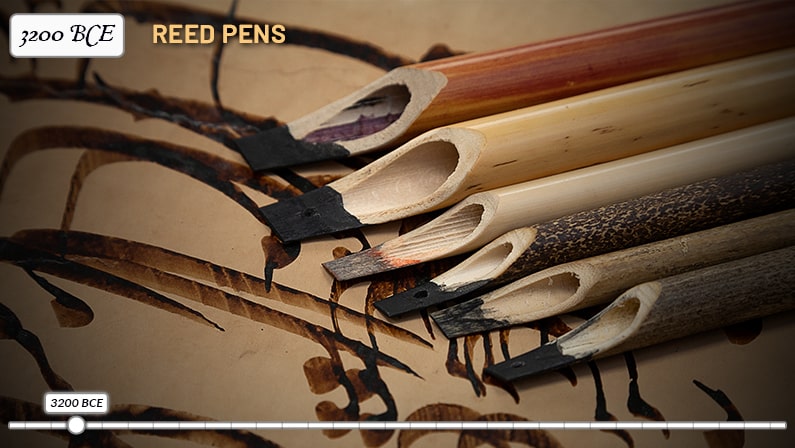
Ancient Egypt's Reed Pens
Around 3200 BCE, ancient Egyptians made their mark on the history of the pen with the reed pen. Fashioned from the stems of reed plants, these pens were filled with ink, then sharpened and split at one end to form a nib, which allowed scribes to create precise and elegant lines.
But what good is a pen without paper? Enter the papyrus scroll, a revolutionary invention that provided a lightweight, portable, and durable surface for writing. Egyptian scribes used their reed pens to write in ink made of soot, water, and a binding agent. The script they crafted, hieroglyphics, was intricate and visually striking.
The innovations of the reed pen and papyrus scroll in ancient Egypt fostered the growth of literature and learning and played a crucial role in record-keeping, trade, and diplomacy. These advancements would continue to shape the development of writing tools for centuries to come.
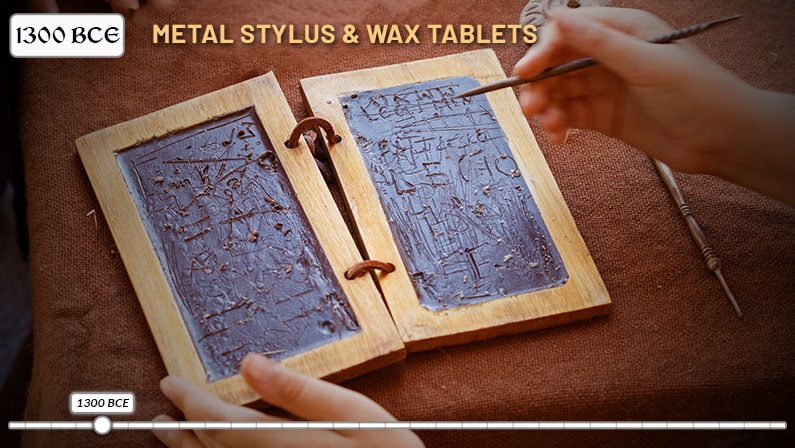
Metal Styluses and Wax Tablets in Ancient Greece
The ancient Greeks made a significant contribution to the history of pens with their use of metal styluses and wax tablets. These portable and reusable writing surfaces were an essential part of daily life in ancient Greece, playing a crucial role in record keeping, journaling, and education. These tablets were practical and efficient, as they could be easily erased and rewritten. One of the oldest wax tablets dates back to the early 14th century BCE, discovered among the artifacts of the Uluburun shipwreck.
Wax tablets were made of wooden frames filled with a layer of wax. To write on these tablets, a metal stylus with a point on one end and a flat edge on the other was used. The pointed end was used to etch words or symbols into the wax, while the flat edge would smooth and erase the writing for reuse.
The influence of ancient Greek and Roman civilizations extended far beyond their borders, and with it, the use of styluses and wax tablets spread to numerous cultures. These writing instruments were instrumental in the exchange of ideas, knowledge, and commerce, solidifying the stylus and wax tablet as integral parts of the ancient world's communication and record-keeping systems.
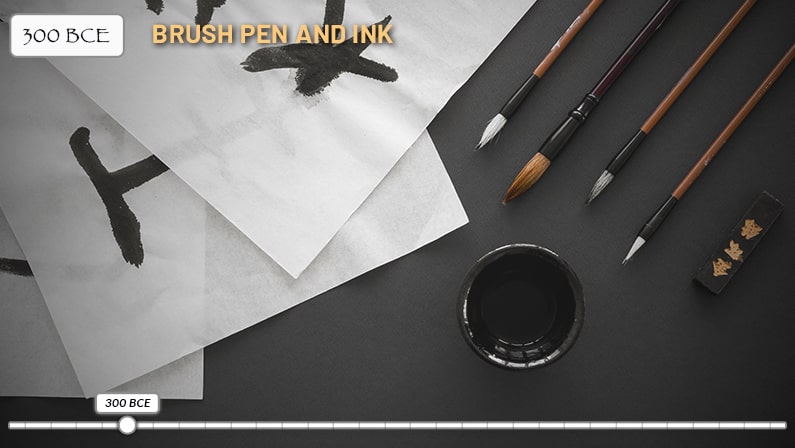
Brush Pens in Ancient China
We can find the next milestone in the pen's storied history in Ancient China around 300 BCE, with the invention of the brush pen. Unlike the reed pens and styluses of the past, the brush pen added a new dimension of artistic grace and fluidity to writing.
The brush pen featured a tip made from animal hair bristles bound to a bamboo or wooden handle. By varying the pressure and angle of the brush, Chinese calligraphers could create a wide range of line thicknesses and styles. Using ink made from ground inksticks and water, this elegant tool allowed for beautiful, expressive writing synonymous with traditional Chinese calligraphy.
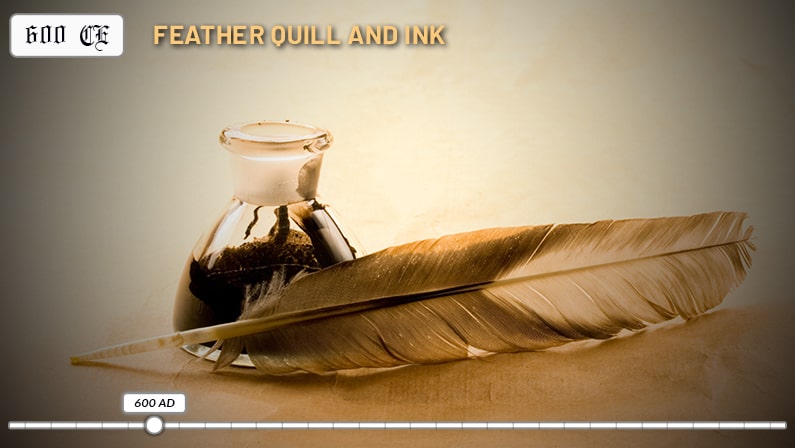
The Era of the Quill
In Spain around 600 CE, a new writing instrument took flight: the quill. Feathered quills, plucked from the wings of birds like geese and swans, became Europe's most common writing instrument, holding sway for over a millennium until the 1800s.
To create a quill, the feather's barbs would be stripped from the lower portion of the shaft, and the tip would be carefully sharpened to a point. A small slit in the tip allowed the quill to hold ink, which flowed smoothly onto the parchment or vellum. Quills played a significant role in shaping history, as they were used to pen countless letters, books, and legal documents that defined the era.
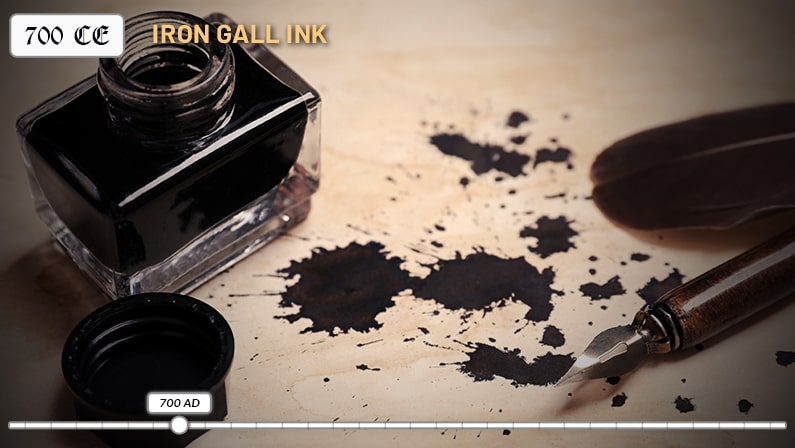
The Invention of Iron Gall Ink
When we look at the history of ink, one variety stands out for its impact and longevity: iron gall ink. This ink was invented around 700 CE in Carthage, made from iron salts and tannin extracted from oak galls. The result was a dark, dense ink that became the go-to choice for scribes and artists, thanks to its ability to create sharp lines and resist fading over time.
One of the most famous manuscripts penned with iron gall ink is the Codex Sinaiticus, a 4th-century Greek Bible that remains one of the oldest and most complete versions of the Christian Bible. This stunningly preserved artifact is a testament to the durability and resilience of iron gall ink, which has allowed the Codex Sinaiticus to survive for centuries and remain an invaluable resource for scholars and theologians.
Iron gall ink's rich, indelible color and enduring quality made it the ink of choice for countless historical documents, artworks, and musical scores.
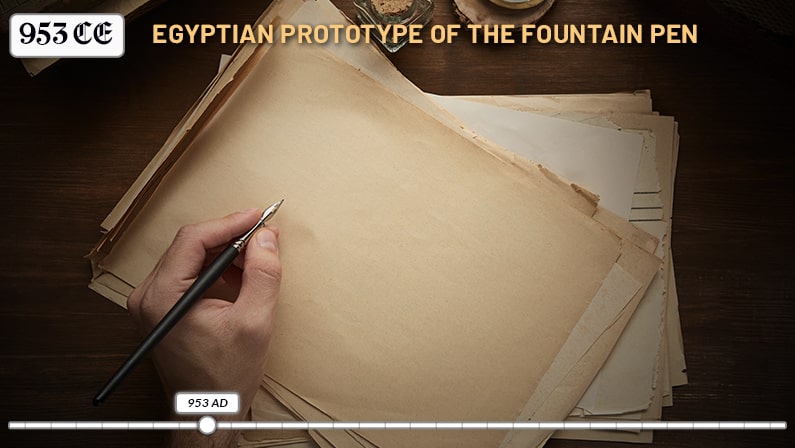
Arab Egypt's Fountain Pen Prototype
The fountain pen is a relatively modern invention, but the history of the fountain pen can be traced back thousands of years. What can be considered the first fountain pen was produced in Arab Egypt in 953 AD. This remarkable invention was designed for the Fatimid Caliph Abu Tamim Ma'ad al-Muizz li-Din Allah, who desired a writing instrument that wouldn't leave his hands stained with ink.
This early fountain pen featured a reservoir of ink and a nib that allowed a continuous ink flow to the writing surface. This ingenious design eliminated the need for constant dipping, offering a more convenient and tidy writing experience fit for royalty. Though this remarkable invention did not gain widespread popularity, the prototype of the fountain pen showed great creativity and innovation.
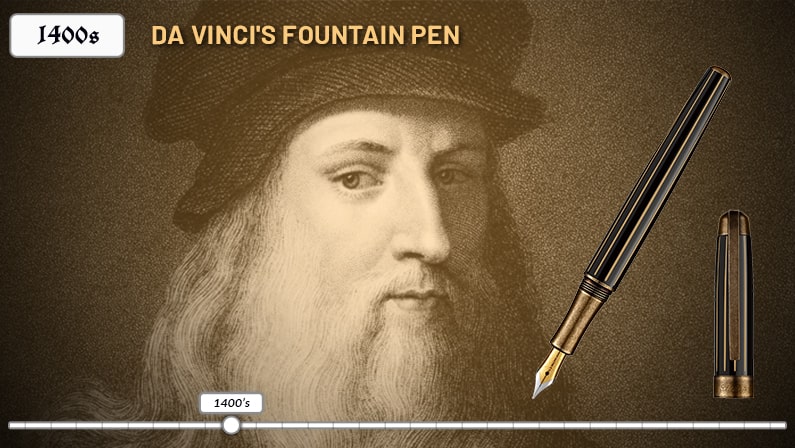
Da Vinci's Fountain Pen
Leonardo da Vinci was known for his incredible inventions and masterpieces like the Mona Lisa, but it's believed da Vinci also dabbled in the world of writing instruments! A prolific inventor, historians believe that he created a fountain pen for personal use due to the consistent contrast in his surviving journals.
Unlike the fading pattern typical of a quill pen caused by re-dipping, the ink in da Vinci's writing is uniform throughout. This observation led scholars to believe that the mastermind crafted a fountain pen with a continuous ink flow, allowing him to craft his brilliant sketches, notes, and ideas without interruption.
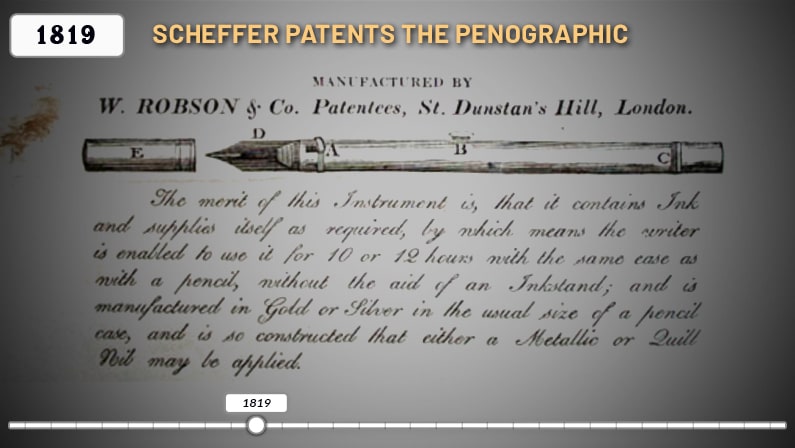
John Scheffer Patents the Penographic
Writing utensils were virtually unchanged from the Middle Ages until the early 19th century. In 1819, John Scheffer, a trailblazer in the world of writing instruments, patented his pen: the Penographic. The Penographic was the first commercially successful fountain pen, bringing the convenience of a continuous ink supply to the masses.
The Penographic was an ingenious blend of old and new, featuring a goose quill for the nib and a pig's bladder for the ink reservoir. To propel ink into the nib, users would exert pressure on a lever and a knob, which controlled the flow of ink and allowed for a smooth, consistent writing experience.
The Penographic may seem rudimentary by today's standards, but it was a significant leap forward in the evolution of the pen. Scheffer's invention paved the way for the development of more advanced fountain pens and marked the beginning of an exciting new chapter in the history of the pen.
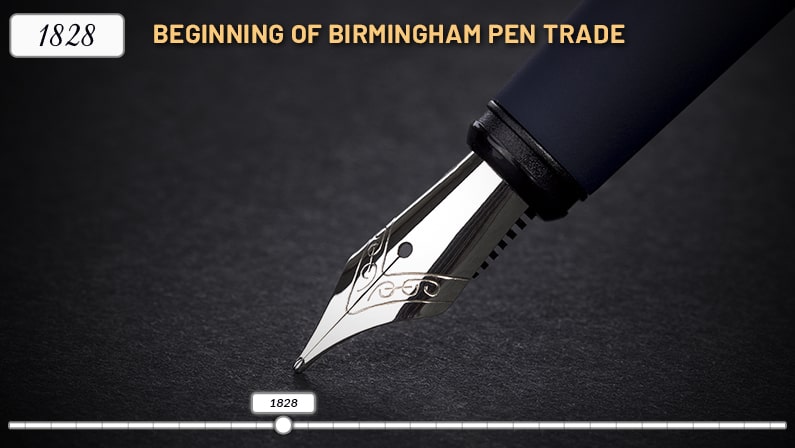
The Birmingham Pen Trade Begins
The Birmingham Pen Trade was a flourishing period of pen manufacturing centered in Birmingham, England, beginning in 1828. Pioneered by visionaries like Josiah Mason and John Mitchell, the city became a hub for the mass production of steel nib pens. At its peak, Birmingham produced an astounding 75% of the world's steel nibs! These innovative and affordable writing instruments took the world by storm, replacing quills and early fountain pens as everyday essentials. Steel nib pens were more reliable and durable than quill nibs, and didn't need to be sharpened.
In 1851, the Great Exhibition in London showcased the Birmingham Pen Trade's achievements, further solidifying its global prominence. The Birmingham Pen Trade played a significant role in making writing accessible to a wider audience, changing how people could communicate and express themselves with the written word.
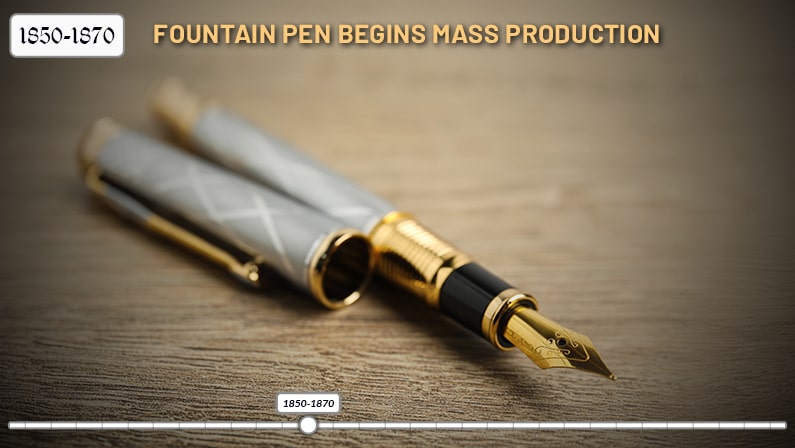
Steel Nib Pens Popularized and Mass Produced
Following the boom of the Birmingham pen trade, the mass production of steel nib pens continued to gain momentum between 1850 and 1870. The increased demand for reliable and efficient writing instruments led to rapid advancements in manufacturing technology and techniques.
During this period, factories were quick to adopt new production methods, such as the use of specialized machinery and automation. This enabled them to produce large quantities of high-quality steel nibs at a lower cost, making writing instruments more accessible and affordable to a wider audience.
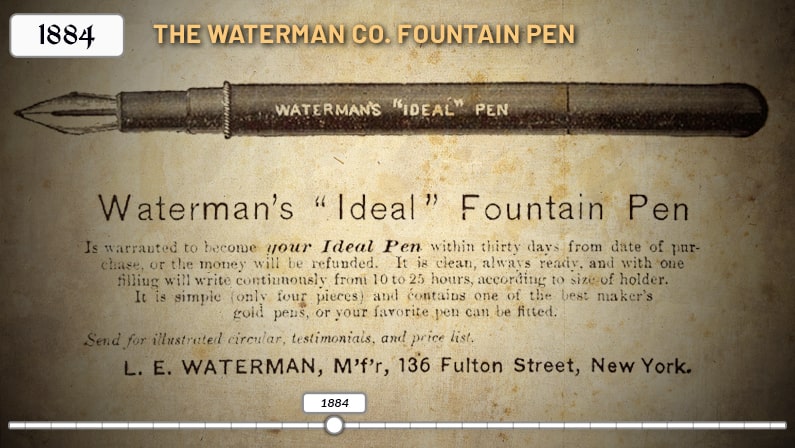
Lewis Waterman and the Waterman Company
Fountain pens saw another breakthrough in 1884, thanks to the Waterman Company. Founded by Lewis Waterman, the company perfected the fountain pen by introducing a reliable and leak-proof design, ensuring users could enjoy a smooth and uninterrupted writing experience. Waterman's invention featured a unique system of air channels that maintained a steady ink flow to the nib while preventing leakage. This game-changing innovation quickly gained popularity and transformed the fountain pen from a luxury item to an indispensable tool for writers everywhere.
But the Waterman Company didn't stop there. They continued to push the boundaries of pen design by developing the first pen clips, making it easy to attach pens to pockets and notebooks. This practical innovation added a touch of convenience and style to the everyday writing experience. The Waterman Company is still a major manufacturer of luxury pens to this day!
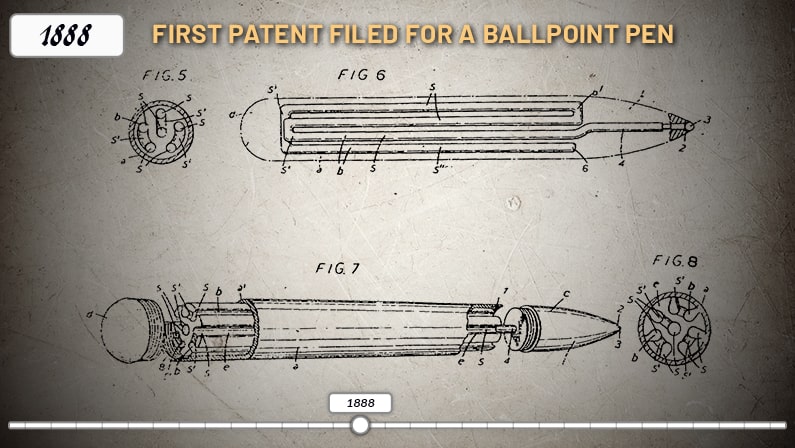
The First Ballpoint Pen
Although it is the standard for pens today, the ballpoint pen was not invented until the late 1800s! In 1888, an American named John J. Loud filed the first patent for a ballpoint pen. Loud's pen aimed to resolve the problems of smudging and inconsistent ink flow that fountain pen users faced.
Loud's ballpoint pen featured a tiny ball bearing in its tip, which picked up ink from the reservoir and transferred it smoothly to the writing surface. Although his invention showed great promise, it was too coarse to write on paper and only suitable for marking leather or wood. Because of this, Loud's pen never saw commercial success. Still, Loud is credited with beginning the history of the ballpoint pen.
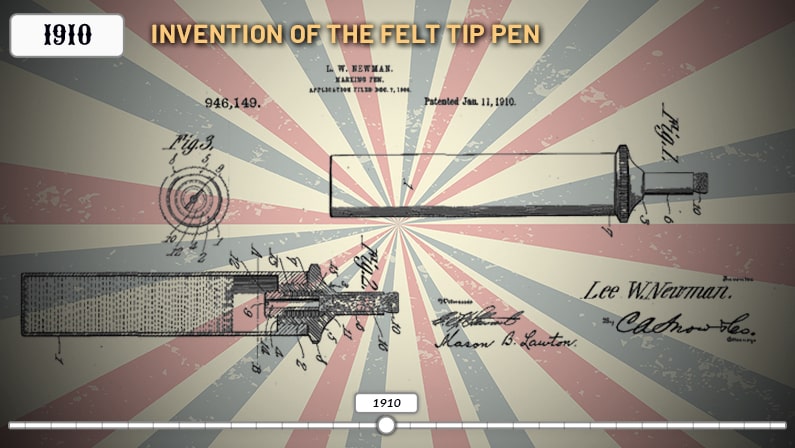
The First Felt Tip Pen
In 1910, there was another major achievement for pens: the invention of the felt-tip pen by Lee Newman. Newman's innovative design featured a barrel filled with ink and a porous, felt-like tip that allowed for a smooth and controlled flow of ink. The felt-tip pen's unique design made it perfect for creating vibrant and precise lines.
Newman's felt-tip pen introduced a new way for artists, writers, and everyday users to express themselves, adding a splash of color and versatility to the world of writing instruments. Felt-tip pens quickly gained popularity among artists, illustrators, and calligraphers for their versatility and ease of use. Over the years, the felt-tip pen has evolved into various forms, including the beloved marker pens and highlighters used today.
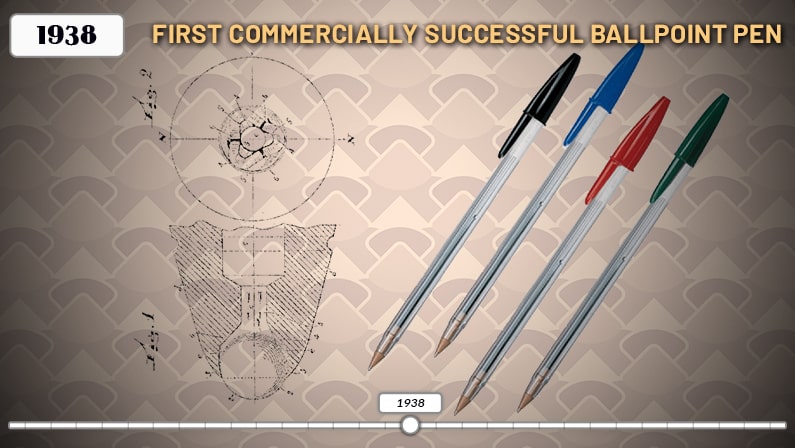
The Ballpoint Pen Sees Commercial Success
The idea for the ballpoint pen was invented in 1910, but it was more than 20 years until it saw commercial success. In 1938, Hungarian journalist Laszlo Biro took up the challenge of perfecting the ballpoint pen. Building on the foundation laid by John J. Loud, Biro sought to create a writing instrument that would be reliable, efficient, and resistant to smudging.
Biro developed a ballpoint pen that provided a smooth, continuous ink flow without needing constant dipping or refilling by refining the ink formula and improving the ball-bearing mechanism. His invention quickly gained the attention of the British Air Force, which appreciated the pen's ability to perform well under various atmospheric conditions.
Biro's ballpoint pen became the first commercially successful model, launching an entirely new era in the history of writing instruments. The ballpoint pen's durability, convenience, and affordability made it an instant favorite for writers worldwide.
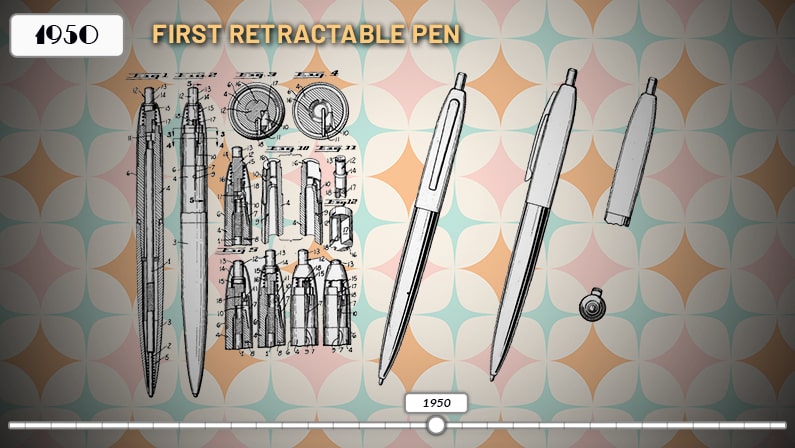
The First Retractable Pen
The retractable pen was invented in 1950 by the Frawley Pen Company. This innovative writing instrument eliminated the need for caps and introduced a new level of practicality to the world of pens. The retractable pen featured a simple yet ingenious mechanism that allowed the user to extend or retract the tip with a click or twist. This clever design protected the pen's tip from damage and prevented ink stains and smudges when not in use.
The retractable pen was a resounding success, quickly becoming a favorite among writers, students, and professionals. Its blend of functionality and elegance has made it a staple of writing instruments, inspiring countless variations and improvements over the years.
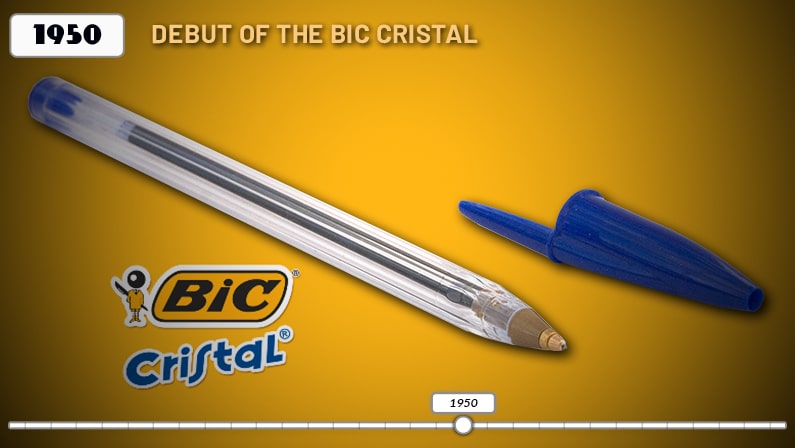
The Launch of the Bic Cristal
In 1950, the world of pens witnessed yet another milestone with the launch of the BIC Cristal. This simple yet elegant ballpoint pen quickly took the world by storm, setting a new standard for affordability, reliability, and style. The BIC Cristal's design has remained unchanged for over 60 years, a testament to its appeal and functionality.
The BIC Cristal, with its hexagonal barrel and transparent plastic casing, was an instant hit among users. Its minimalistic design, reliable performance, and low price made it accessible and attractive to a wide range of consumers. The pen's widespread popularity soon catapulted it to become the best-selling pen in the world, a title it still holds today.
The significance of the BIC Cristal cannot be overstated. Its launch marked a turning point in the pen industry, making quality writing instruments accessible to people from all walks of life. The BIC Cristal's lasting success and timeless design serve as a reminder of the power of simplicity.
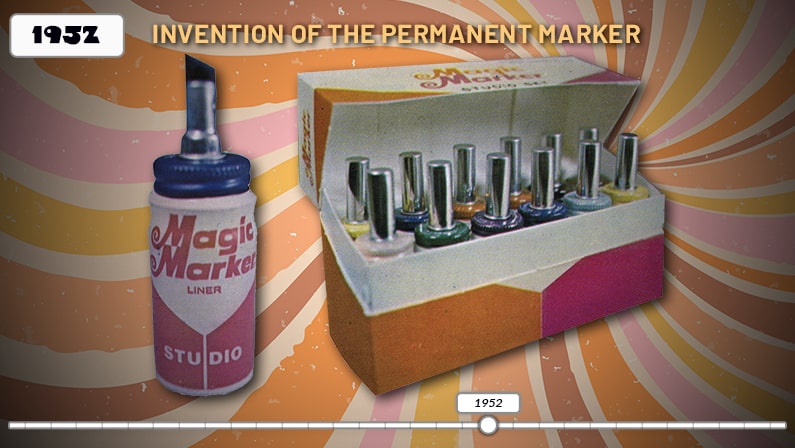
Sidney Rosenthal and the Permanent Marker
In 1952, the permanent marker was invented by Sidney Rosenthal. This bold and versatile tool allowed users to make their mark on a wide range of surfaces, making it an instant favorite among artists, industrial workers, and business people. Rosenthal's Magic Marker featured a fiber tip and a reservoir filled with quick-drying, water-resistant ink that could adhere to virtually any surface, including glass, metal, and plastic. The invention of the permanent marker opened up a world of creative possibilities, allowing users to write, draw, and label materials that were previously off-limits to traditional pens.
The permanent marker's impact was felt not only in the realms of art and design but also in various industries, where its durability and versatility proved invaluable for tasks such as labeling and organizing. Today, permanent markers come in various colors, tip sizes, and formulations and are indispensable in countless applications.
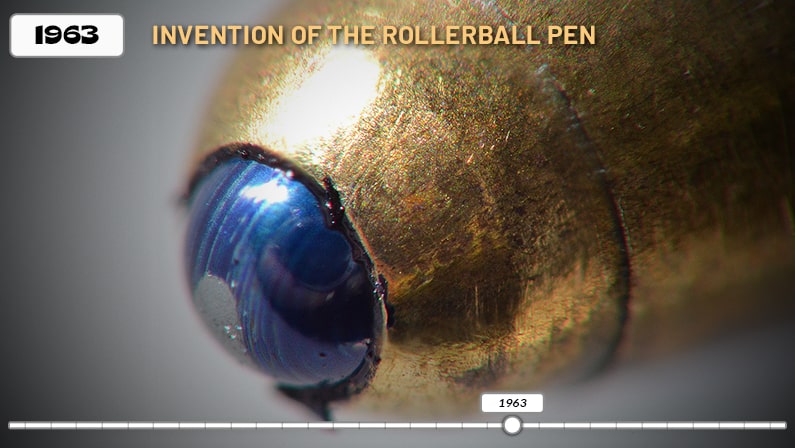
OHTO invents the Rollerball Pen
In 1963, the smoothest writing instrument was born: the rollerball pen, invented by Nakata Touzaburo for the Japanese company OHTO. This innovative pen combined the smooth ink flow of a fountain pen with the convenience and reliability of a ballpoint pen, offering users the best of both worlds.
OHTO's rollerball pen featured a tiny rolling ball in the tip, similar to a ballpoint pen, but used a water-based liquid or gel ink instead of the oil-based ink typically found in ballpoints. This unique combination resulted in a smoother, more consistent writing experience that closely mimicked the feel of a fountain pen while retaining the ease and durability of a ballpoint pen.
Although the rollerball pen was invented in the 1960s, it gained popularity in the 1970s. It became a sought-after writing instrument among writers who desired the elegance of a fountain pen without the maintenance and potential mess. Today, rollerball pens are beloved by professionals, artists, and everyday users alike for their precise lines and effortless glide across the page.

The Fisher Space Pen
The Fisher Space Pen represents a giant leap forward in the history of writing instruments. Invented by Paul C. Fisher in 1965, this remarkable pen was designed to defy the challenges of writing in space, making it an invaluable tool for astronauts and a symbol of human ingenuity.
Fisher's Space Pen is built with a pressurized ink cartridge, allowing it to write smoothly and reliably in zero gravity, extreme temperatures, and even underwater. The pen's ink is also specially formulated to prevent leakage and evaporation, ensuring it remains functional and reliable in the harshest environments.
The Fisher Space Pen gained global recognition when it was adopted by NASA for use on the Apollo missions, proving its worth during critical moments in space exploration. It has become a staple on subsequent space missions, including those by Russian cosmonauts and the International Space Station crew.
The Space Pen's influence extends beyond the realm of space travel, as its unique features have made it a favorite among outdoor enthusiasts, military personnel, and anyone in need of a reliable writing instrument in extreme conditions.
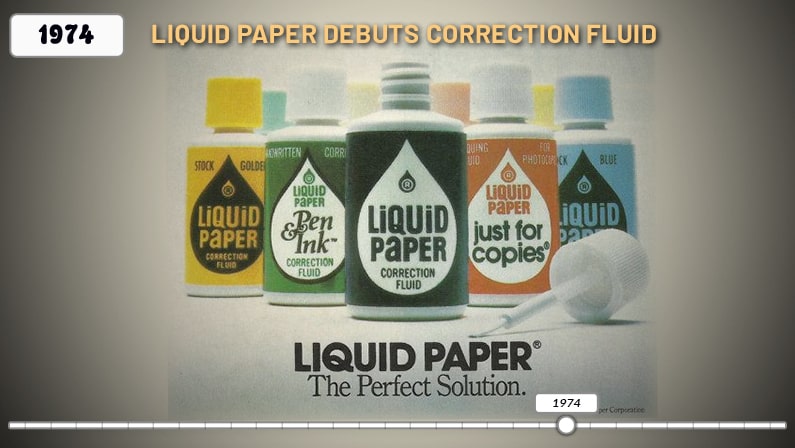
The Launch of Liquid Paper
In 1974, a revolutionary product made its way into the world of writing instruments: correction fluid, offering users a convenient solution for correcting their mistakes. The brainchild of Bette Nesmith Graham, a single mother and secretary, Liquid Paper was initially developed in her kitchen.
Graham recognized the need for an easy-to-use product that could neatly and effectively correct errors made with ink. The solution she created was a fluid that could be painted over mistakes, providing a clean, white surface to write on once dry. The introduction of correction fluid was a game-changer, making correcting errors in documents and handwritten work easy. Liquid Paper's success paved the way for various correction products like correction tape, further expanding how we can address and fix our writing mistakes.
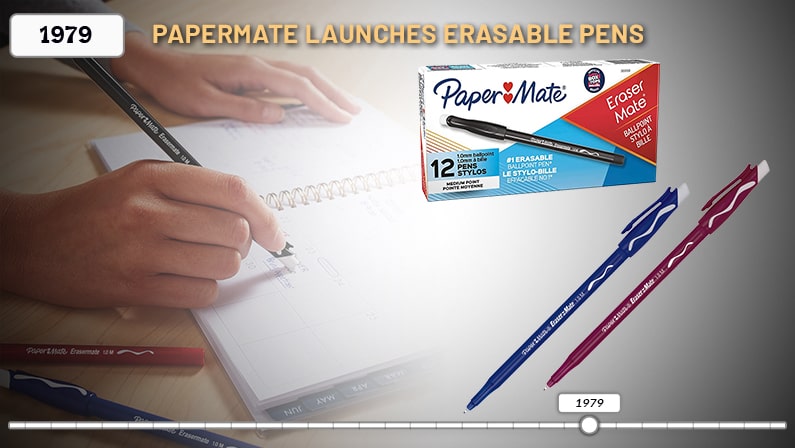
Papermate Creates Erasable Pens
In 1979, Papermate launched a groundbreaking product that changed the landscape of writing instruments: the Erasermate. This innovative pen introduced the world to the magic of erasable ink, allowing users to write and rewrite as needed without the permanence of traditional ink pens.
The Erasermate featured a unique ink formula that could be easily erased using a specially designed eraser built into the pen. That allowed users to correct mistakes on the fly, making it an instant hit among students, writers, and professionals who appreciated its added control and versatility.
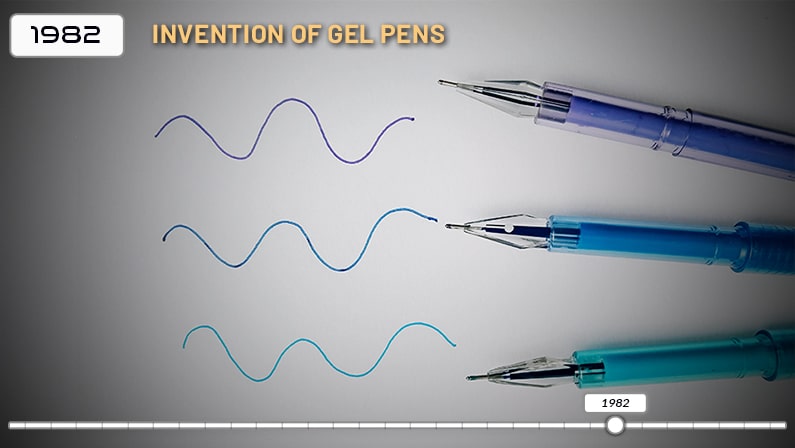
The First Gel Pens
The history of pens took a colorful turn in 1982 with the invention of gel pens by the Japanese pen maker Sakura. These vibrant writing instruments offered users a new experience, combining the smoothness of ballpoint pens with the bold, vivid colors of gel ink.
Gel pens featured a unique ink formulation of water, pigment, and a gel-based thickener. This ink allowed the pens to produce richer, more intense colors and enabled them to write on various surfaces, including dark and glossy materials. The introduction of gel pens brought an explosion of creativity to the writing world with their striking hues and effects like metallic, glitter, and neon.
Artists, writers, and craft enthusiasts embraced gel pens for their ability to add a touch of flair and personality to their work. Over the years, gel pens have become a staple of writing instruments.
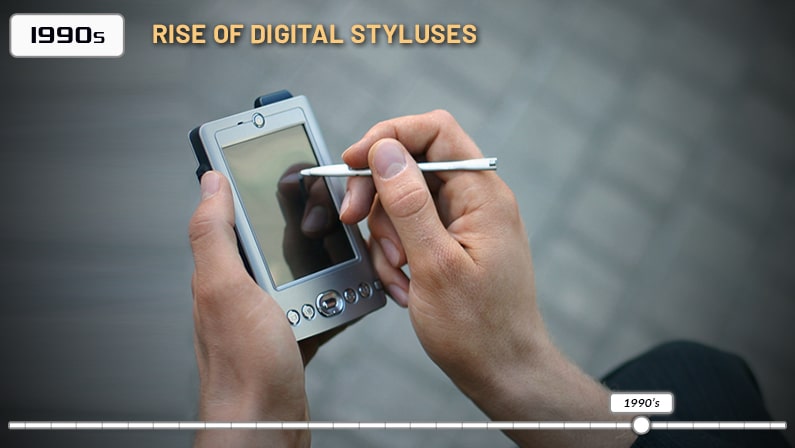
Digital Styluses Become Popular
The 1990s marked the beginning of a new chapter in the history of writing instruments as digital styluses emerged to meet the demands of a rapidly advancing digital world. These innovative tools gained prominence with handheld gadgets such as the Palm Pilot, which revolutionized how people managed their schedules, notes, and contacts.
Early digital styluses were designed to mimic the feel and function of a traditional pen while offering a more intuitive way for users to interact with their electronic devices. These styluses were capacitive, using the human body's natural conductivity to register touches on a screen. The introduction of digital styluses provided a more precise and efficient input than fingers, paving the way for a new generation of touchscreen devices.
The Palm Pilot, released in 1996, was among the first devices to popularize digital styluses. Its compact design and user-friendly interface allowed users to easily manage their daily tasks, using a stylus to write and navigate. The success of the Palm Pilot and similar devices signaled the beginning of a new era of digital organization and communication, with digital styluses playing a pivotal role.
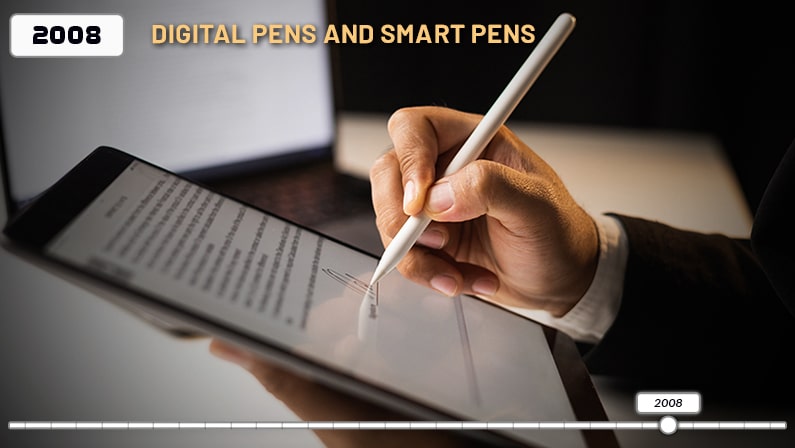
Digital Pens and Smartpens
In 2008, the field of writing instruments had a breakthrough with the widespread adoption of digital pens and smartpens. These modern tools, designed to work in tandem with tablets and digital sketchpads, brought new capabilities to the worlds of education, design, and communication. Digital pens offer users a seamless connection between the physical act of writing and the digital realm. By incorporating sensors and advanced technology, these pens could capture handwriting, sketches, and notes, converting them into digital formats that could be easily stored, shared, and edited.
In educational contexts, smartpens allow learners to create interactive multimedia notes that enhance the learning experience. For designers and artists, the ability to sketch and create directly on digital devices opened up a world of collaboration and experimentation. And in communication, digital pens provided a more personal and expressive way to connect with others through handwritten messages and annotations.
As digital devices evolved, so did the digital pen, with manufacturers adding features such as pressure sensitivity, palm rejection, and Bluetooth connectivity. These enhancements allowed users to write, draw, and navigate with increased accuracy and control. Over the years, digital pens have become an essential tool for artists, designers, and professionals who rely on digital devices for their work.
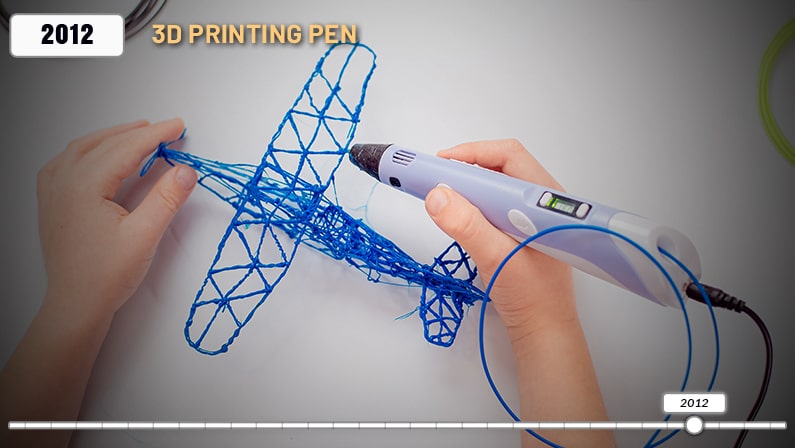
3D Printing Pens: Turning Sketches into Reality
3D printers, first introduced in the 1980s, revolutionized the manufacturing world. In 2012, a groundbreaking innovation was made with the invention of the 3D printing pen. Developed in Massachusetts, this extraordinary tool opened up a new realm of possibilities, enabling users to create three-dimensional objects by drawing in mid-air.
3D printing pens function by heating and extruding a plastic filament, which instantly solidifies upon contact with the air. This allows users to build structures, layer by layer, turning their imagination into tangible, 3D creations. Since their introduction, 3D printing pens have advanced significantly in precision, control, and versatility, making them a popular choice for artists, designers, hobbyists, and educators.
Today's 3D printing pens offer a wide range of features, such as adjustable temperature settings, variable extrusion speeds, and compatibility with various types of filaments. These advancements have expanded the creative potential of 3D printing pens, enabling users to experiment with different textures, finishes, and artistic styles.
The 3D printing pen represents a leap forward in the evolution of writing instruments, pushing the boundaries of what is possible and empowering creators to explore new frontiers in art, design, and technology. These pens challenge our perception of what a writing instrument can be, opening up a world of endless possibilities.
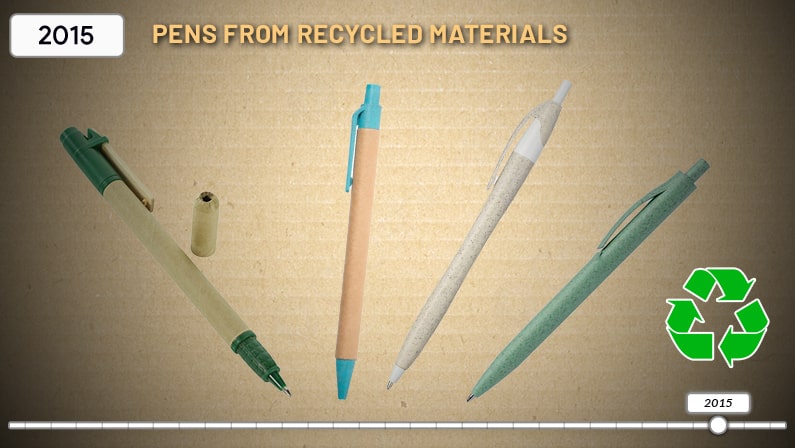
Promoting Sustainability with Eco-Friendly Pens
Protecting the environment has been a huge part of society's agenda in the 21st century. Writing utensils jumped on board in 2015 as Papermate introduced the first pens ever made from recycled materials! These eco-friendly pens sought to address the growing concerns about plastic waste and environmental impact.
Using recycled materials to create pens reduces reliance on non-renewable resources and helps divert plastic from landfills and oceans. By repurposing plastic waste, companies like Papermate are taking a proactive approach to address environmental challenges and promote a more circular economy.
Since the release of Papermate's first recycled pen, other manufacturers have followed suit, creating a wide range of eco-friendly writing instruments. These pens come in various styles and designs, from ballpoint and gel pens to fountain pens and even markers, making it easy for consumers to make environmentally conscious choices when selecting their writing tools.

Fighting the COVID-19 Pandemic with Antimicrobial Pens
Although antimicrobial pens were first invented in 2010, their popularity surged during the unprecedented times of the COVID-19 pandemic. As people worldwide became increasingly aware of the importance of hygiene and infection prevention, these pens offered a practical solution for reducing the spread of germs in everyday life.
Antimicrobial pens are designed with special coatings or infused materials that actively inhibit the growth of bacteria, viruses, and fungi on their surfaces. This feature helps keep the pens cleaner and contributes to a more hygienic environment, minimizing the risk of cross-contamination when shared among multiple users.
During the COVID-19 pandemic, the demand for antimicrobial pens rose as businesses, healthcare facilities, schools, and households sought ways to maintain cleanliness and protect themselves from potential infection. These pens became an essential tool in promoting hygiene practices, providing extra protection in high-touch situations.
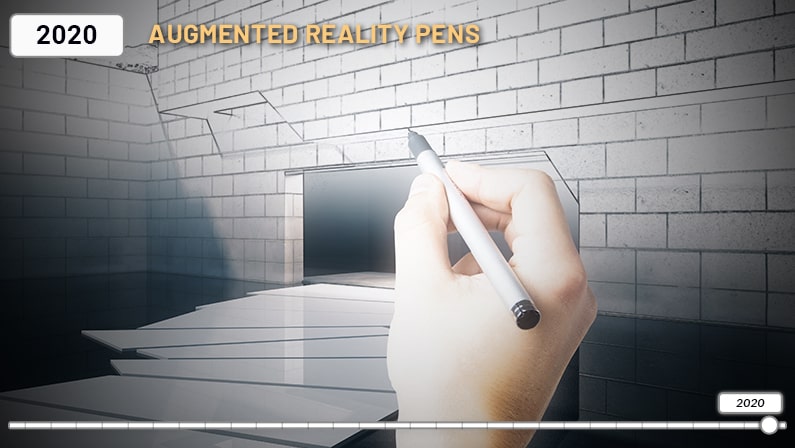
Augmented Reality Pens Redefine Writing
The most recent development in the world of pens took place in 2020 with the introduction of augmented reality pens. These cutting-edge tools bring a new level of interactivity and creativity to writing and drawing, allowing users to see their creations come to life in a three-dimensional, virtual space.
Augmented reality pens use advanced sensors and technology to capture and track the user's pen movements. This data is then processed and translated into digital images projected onto the real world using a smartphone, tablet, or AR headset. The result is a seamless blend of physical and digital, allowing users to create and interact with their drawings and designs in an entirely new way.
Augmented reality has opened up a world of possibilities for artists, designers, educators, students, and architects alike, offering a fresh perspective on traditional writing and drawing techniques. For architects, in particular, these pens enable them to visualize their designs in a three-dimensional space, providing a powerful tool for conceptualizing and refining building plans. They enable users to explore new creative avenues, experiment with different styles and materials, and even collaborate with others in real time through shared virtual spaces.
These pens represent yet another leap forward in the ever-evolving world of writing instruments, pushing the boundaries of our imagination and creating new frontiers in art, technology, and communication. They remind us that the possibilities for creativity and expression are limitless, redefining our relationship with writing and drawing in the digital age.
Commonly Asked Questions about the Pen
Who Invented the First Pen?
The history of pens dates back thousands of years, with the Egyptians credited for inventing the first pen with their reed pens around the fourth millennium BCE. These pens were made from a sharpened reed and used to write on papyrus scrolls, laying the groundwork for future writing instruments.
While the concept of a pen has evolved significantly over time, the reed pen holds a special place as the origin of this essential writing tool. Over centuries, prominent civilizations built upon this invention, leading to the diverse array of writing instruments we use and appreciate today.
When Was Ink First Used?
Ink has a long and storied history, with Egypt and China independently inventing their own forms of ink. In Egypt, ink was first used around the 26th century BCE, while in China, it dates back to the 23rd century BCE. In ancient Egypt, ink was typically made from carbon black, mixed with water and a gum binder, and used for writing on papyrus scrolls. In ancient China, plant, animal, and mineral-based inks were created from materials such as graphite. These were ground with water and applied using ink brushes on silk or paper.
Ink played a crucial role in the development of written communication and record-keeping in ancient times. It allowed people to document important information, convey messages, and express their thoughts with a permanent medium.
Quills vs. Reed Pens: Where Were They Used?
Reed pens and quills are ancient writing instruments with distinct geographical and historical origins. Reed pens, first used in Egypt around the fourth millennium BCE, were made from sharpened reeds and employed for writing on papyrus scrolls. They were also used in Mediterranean regions like Greece and Rome. Reed pens gradually fell out of use with the decline of papyrus and the rise of alternative writing materials and instruments, like the quill.
Quills, invented in Spain around 600 AD, were made from the flight feathers of large birds and became the prevalent writing tool in Europe during the Middle Ages. They were used for writing on parchment or vellum. Quills' dominance lasted until the 19th century, when steel nibs and fountain pens began to replace them.
When Did Ballpoint Pens Become More Popular Than Fountain Pens?
Ballpoint pens began gaining popularity after being adopted by the Royal Air Force during World War II. However, the launch of the Bic Cristal in 1950 truly catapulted ballpoint pens to widespread success. Ballpoint pens grew in popularity throughout the 1960s and 1970s, eventually replacing fountain pens as the most common writing instrument. This shift can be attributed to the ballpoint pen's affordability, reliability, and ease of use, making it an appealing choice for everyday writing tasks.
When Were Pens First Used as Promotional Products?
Pens began to be used as promotional products in the 1930s, with some of the earliest examples including pens featuring popular characters like Mickey Mouse and Popeye. Another iconic promotional pen from this era was shaped like a Pepsi bottle, showcasing the power of branding through writing instruments. These early promotional pens paved the way for businesses to market their brands effectively using everyday items.
Today, branded pens are a popular marketing tool! At Logotech, we offer thousands of custom pens to suit various business needs. From affordable plastic pens to high-quality metal pens, we have bulk options available for every company! So, whether you're a small business or a large corporation, consider Logotech to help you create the perfect promotional pen to promote your brand's message.
In Conclusion
The remarkable journey of the pen, from its humble beginnings as a tool for cave paintings to the advanced digital writing instruments we use today, shows the unlimited nature of human creativity. The pen has seen many milestones over the centuries, such as the emergence of the reed pen in ancient Egypt, the prominence of the quill in medieval Europe, and the practicality of the ballpoint pen in the modern age.
Throughout its rich history, the pen has continually adapted to the changing world, enabling the spread of knowledge, culture, and artistic expression. It has also found its place as a powerful promotional tool, helping businesses leave a lasting impact on their audience. As we reflect on the milestones in the pen's timeline, it's easy to appreciate the legacy of this writing instrument. While we can't predict what the future of pens holds, it's clear they will remain an essential part of our lives, facilitating communication and creativity for generations to come.








